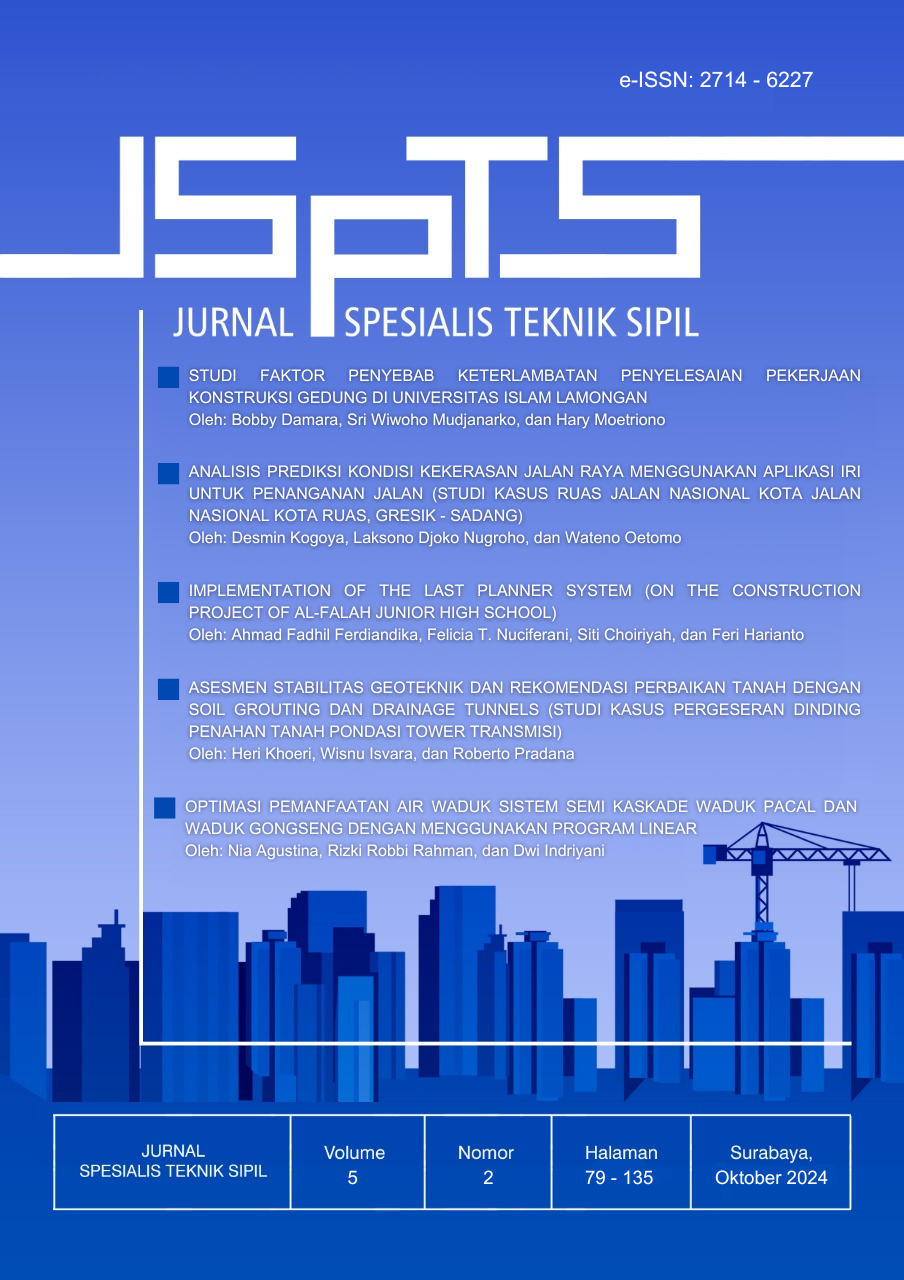Implementation Of The Last Planner System (On The Construction Project Of Al-Falah Junior High School)
Abstract
Currently, the construction sector is adopting the theory of production in the manufacturing industry, known as lean construction, to reduce waste and increase value. Last Planner System (LPS) has not been widely used and has good potential because the advantage of LPS is to identify a job along with obstacles to improve performance in a construction project. In the construction of Junior High School (SMP) Al-Falah, it has work obstacles due to erratic weather so that the project is delayed, the author conducts a field survey to analyze the actual progress in the field, LPS has work indicators / work flow to measure the extent to which work indicators can be realized properly, the LPS work flow are Master Plan, Phase & Pull Planning, Lookahead Planning, Constraints Analysis, Shielding Production, and Percent Plan Complete (PPC) as a standard for measuring whether project productivity is realized properly or not. In this study, the results of the implementation using LPS on the Al-Falah Junior High School construction project show that the lowest PPC can be seen in week 7, which is 0% because there is no work achievement so that the work is delayed, while in week 16 it can be seen that PPC has increased dramatically to 96%. Then after averaging the PPC of 51% which means that LPS has not been able to increase the reliability of planning above 70%, (Ballard, 2000).
Downloads
References
AlSehaimi, A., Tzortzopoulos, P., & Koskela, L. (2009). Last Planner System: Experiences from Pilot Implementation in The Middle East. Proceedings for the 17th Annual Conference of the International Group for Lean Construction.
Ballard, G. (2000). The Last Planner System Of Production Control (Theses). The University of Birmingham.
Ballard, G., & Howell, G. A. (2004). An Update on Last Planner, Proceeding of IGLC 11, Virginia, USADaniel, E.I., Pasquire, C., and Dickens, G. (2016). “Exploring the Factors that Influence the Implementation of the Last Planner System on Joint Venture Infrastructure Projects: A Case Study Approach.” ”, In: Proc. 24th Ann. Conf. of the Int’l. Group for Lean Construction.
Forbes, L. H., & Ahmed, S. M. (2011). Modern Construction : Lean Project Delivery and Integrated Practices. CRC Press.
Heizer, Jay, & Barry Render. (2009). Manajemen Operasi buku 1. Salemba Empat.
Human, A. D., & Zuldi, S. (2018). Penilaian Kesiapan Praktisi Indonesia Terhadap Last Planner System. Universitas Diponegoro.
Koskela, L. (1992). Application of the New Production Philosophy to Construction. Standford University.
Koskela, L., Greg Howell, Glenn Ballard, & Iris Tommelein. (2002). The foundation of lean construction. In: Best, R., and Valence, G. D., eds. Design and Construction: Building in Value, 211–226.
Steven, S., Robby, R., & Andi, A. (2013). Perhitungan Percent Plan Completed Dan Identifikasi Faktor Tidak Tercapainya Rencana Pekerjaan Pada Suatu Proyek Konstruksi. Jurnal Dimensi Pratama Teknik Sipil, 2(2).
Copyright (c) 2024 Jurnal Spesialis Teknik Sipil (JSpTS)

This work is licensed under a Creative Commons Attribution 4.0 International License.








